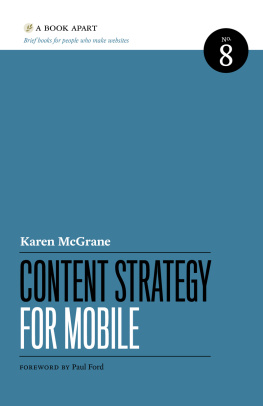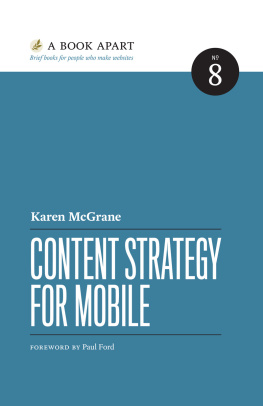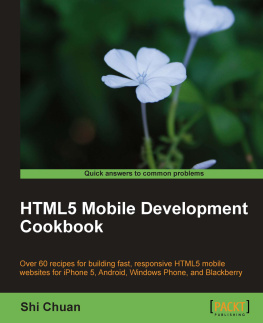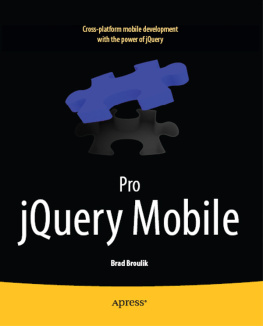WHEN PEOPLE develop websites they talk about users. Users are weird creatures with strange intentions. They click everything, even where they are not supposed to. They rarely follow instructions. They are unpredictable. And yet we must love them. That is our job. Even when they are hard to love, even when they send us angry emails or tweet about how stupid we are.
When people talk about content they discuss readers. Readers are a known quantity. They start at the top of a page and go to the bottom, sentence by sentence. Sometimes they might skim, but often theyre fully engaged. They pause and think things through. They might even read the same section twice.
The reader is, of course, easy to love. Because the reader is us.
It is better to have 100 functions operate on one data structure, wrote computer scientist Alan J. Perlis, thirty years ago, than ten functions on ten data structures. He meant: focus on your data, then code around it. Applications are there to serve the data, not the other way around.
Its a simple lesson but hard to follow. Mobile websites and custom apps have proliferated at a furious rate. They are costly and complex and have special data needs; ministering to those needs can take away from your ability to create great content. Worse, there are ever-more platforms. Theres iOS and Android and Kindle Fires and the web; email and SMS and Facebook, Twitter, or Pinterest. Every platform tells you that its the best, that it is worthy of your time and attention. But theres always another platform.
Lets put it another way: it is better to have 100 platforms operate on one content model than to have ten platforms on ten content models.
Theres a huge lesson in this book: that users have been readers all along. The rise of mobile platforms just makes this fact plain. Reader-users read differently than their forebearsthey read Twitter to find links to long articles that will interest them; they switch between phone calls and the Kindle app. And yes, they watch video, play games, and listen to music. But language still knits it all together, and words have more work to do than they ever did before.
The readers freedom, writes the essayist William Gass, is a holy thing. As content strategists we are responsible for preserving that freedom. Its a significant responsibility. Trust in the content, in the words, images, and experiences. Let content leadthe rest will follow.
INTRODUCTION
Theres no such thing as content strategy for mobile.
Wait! Dont throw the book away yet!
There is such a thing as a content strategy that plans for how youll publish and maintain your content across all these new and emerging platforms: smartphones and tablets, sure, but also smart TVs, refrigerators, in-car audio systemseven the desktop web. But holistic enterprise content strategy just doesnt have the same ring to it, right? Mobiles the buzzword on everyones lips right now, so thats the label weve slapped on this problem.
When we talk about content strategy for mobile, were not talking about publishing different content to be read on smartphones. That wouldnt be much of a strategywho can afford to create content for only one platform? If content strategy means developing a plan for how you will create, deliver, maintain, and govern your content, then content strategy for mobile looks at the special challenges in getting your content onto a variety of devices, screen sizes, and platformsincluding mobile web, native apps for iOS, Android and Windows, and, yup, even the desktop.
When we talk about content strategy for mobile, were also not talking about delivering content to serve the mobile context. Mobile seemingly implies motion, mobility. We imagine a hurried businesswoman, dashing through the airport, glancing at the screen out of the corner of one eye. But like the dial tone, the return key, and cut and paste, the word mobile has expanded to mean something different from its analogue in the physical world. Anyone whos ever pecked at his mobile phone from the couch, too lazy to walk over to his desktop computer just a few feet away, knows exactly what were talking about. Anyone whos ever waited for hours in that same airport, passing the time transfixed by a tiny glowing screen, knows the same thing. Mobile doesnt necessarily mean youre on the move.
If mobile doesnt imply a specific device or a specific context, then what does it mean? The only thing it really tells us is that the user isnt seated at a computer, with all that tells us about the interaction model. With a desktop machine, we can assume the user has a monitor, and we can know with almost total certainty that the monitor has a resolution of 1024768 pixels or higher. We can assume the user has a pointer, controlled by an external pointing device like a mouse or a trackpad. We can probably assume that the user has a broadband connection.
When we say someone is on mobile, all we know is theyre using a device that isnot a desktop. We know very little about what they see and how they interact. They might have a tiny 240320 BlackBerry Bold screen, or a glorious iPad 20481536 Retina display, large enough to rival even a desktop monitor. Their pointing device might be as direct as touching the screen with their fat, greasy fingers, or as abstract as navigating with a four-way rocker. They might have a connection thats no better than a 56K modem, or a connection thats as zippy as a full-fledged workstation with a dedicated T3 connection. All we know is that we cant really count on anything.
Daunting, right? How are we supposed to make good design decisions if we dont know the boundaries of what the user will see? How do we structure information, if we dont know how the user will navigate and make selections? Most important, how do we know what content someones going to want, when we dont know anything about their context?
It seems that many businesses are choosing to answer these questions by hiding their heads in the sand. No one will ever want to do that on mobile, they insist. Only a fraction of our visits today come from mobile devices, they sigh. Users need only location-based services on mobile, they say, stubbornly.
If theres one thing we should have learned from the web, its that user behavior evolves more quickly than businesses realize. User expectations evolve and move forward, and only later do organizations hurry to catch up. If youre wondering if youre going to need to invest in getting your content on mobile, quit hoping you wont have to. Your customers are already there.
What youll get from this book
This book discusses why and how to get your content onto many different devices, platforms, screen sizes, and resolutions. Content includes your text, images, videos, charts, and any other forms of information your reader might want from you.
While the smartphone isnt the sole focus of this book, many of the examples will focus on smartphones because they are both the most common device and most challenging form factor. Getting content onto mobile phones is top of mind for many organizations.
If youre stuck on whether and why to be on mobile, this book can help you make the case. Youll get data and statistics about how people use their phones today, including insight into emerging audiences like the mobile-mostly user. Youll also get analysis and rationale about why its important to get









